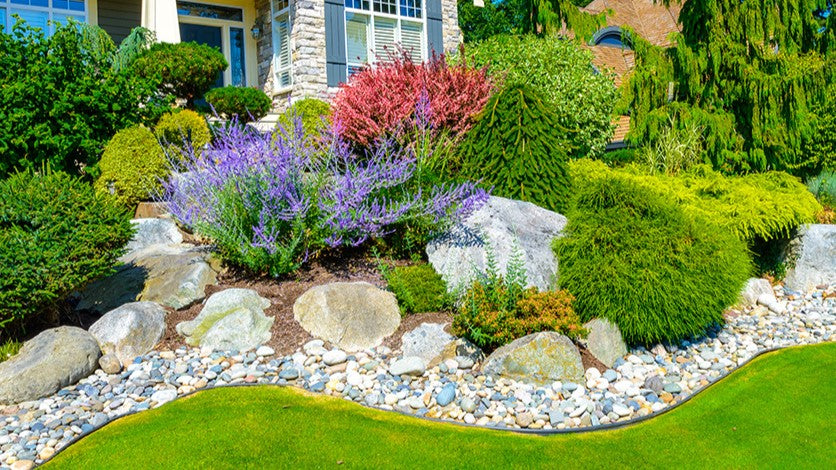How Do I Create a Water-Wise Landscape

Water bills climbing? Plants struggling despite constant watering? You're not alone. Creating a water-wise landscape isn't just about saving money—it's about building a thriving outdoor space that works smarter, not harder.
Bottom line: A well-designed water-wise landscape can cut your outdoor water use by 30-50% while actually making your yard look better and easier to maintain.
Understanding Water-Wise Landscaping
Water-wise landscaping (also called xeriscaping) means designing and maintaining your landscape to minimize water waste while maximizing plant health and visual appeal. Think of it as working with nature instead of against it.
Why it matters: Traditional landscaping can waste 30-70% of water through overwatering, poor timing, and inefficient systems. Water-wise landscaping flips this equation, using smart plant choices, soil improvements, and efficient irrigation to create landscapes that thrive with less water.
The payoff: Beyond lower water bills, you'll get healthier plants, less maintenance, and a landscape that stays beautiful even during drought conditions. Plus, you're doing your part for the environment.
Planning Your Water-Wise Landscape
Start with a water audit. Walk your property and note where water pools, where plants struggle, and where you see runoff. This tells you everything about your current water patterns.
Key design principles:
- Group plants by water needs. Put thirsty plants together where you can easily water them, and drought-tolerant plants in areas that rely on natural rainfall.
- Work with your slopes. Plant water-loving plants at the bottom of slopes where water naturally collects, and drought-resistant plants higher up.
- Create microclimates. Use larger plants to shade smaller ones, and position plants to take advantage of natural wind patterns and sun exposure.
Make a simple plan. Sketch your yard and mark different zones based on sun exposure, water needs, and how you use each area. This doesn't need to be fancy—just clear enough to guide your plant and irrigation choices. Or reach out to your local extension office, they can help you though the process.
Soil Preparation Techniques
Healthy soil holds water like a sponge. Poor soil either repels water or lets it drain away too quickly. Either way, your plants suffer and you waste water.
Test your soil texture. Fill a jar halfway with soil, add water until almost full, shake for 60 seconds, then let it settle. You'll see distinct layers: sand (bottom), silt (middle), and clay (top). The ideal water-wise soil has a good mix of all three. You can also work with your local extension office for a professional test.
Improve your soil structure:
- For clay soil: Add some coarse sand and lots of organic compost to improve drainage and prevent waterlogging.
- For sandy or silty soil: Mix in compost and aged manure to help retain moisture and nutrients.
- For all soil types: Add 2-3 inches of organic matter annually. This creates the perfect balance of drainage and water retention.
Organic amendments that work: Compost, aged manure, leaf mold, and wood chips all improve soil water-holding capacity. Work these into the top 8-12 inches of soil before planting.
Selecting the Right Plants
Go native first. Native plants have spent thousands of years adapting to your local climate. They know how to handle your summers, winters, and everything in between—with minimal water.
Choose drought-resistant varieties: Look for plants with these water-saving features:
- Small, thick, or waxy leaves (they lose less water)
- Deep root systems (they find water on their own)
- Gray or silvery foliage (reflects heat and reduces water loss)
Create visual interest with variety: Mix different textures, heights, and colors. Combine spiky agave with soft ornamental grasses, or pair purple lavender with silver-leafed artemisia. The key is choosing plants with similar water needs for each area.
Smart plant placement: Put your highest-water-use plants closest to the house where you can easily reach them with a hose. Place drought-tolerant plants farther out where they can rely more on natural rainfall.
Implementing Efficient Irrigation Practices
The right irrigation system makes all the difference. Poor irrigation wastes water and money while stressing your plants.
Drip irrigation wins for water efficiency. It delivers water directly to plant roots with 90% efficiency compared to 60-70% for sprinklers. For quick installation without tools, Blu-Lock and Drip-Lock fittings let you connect tubing 80% faster than traditional fittings while creating 25% stronger connections.
Smart controllers save water automatically. B-hyve smart controllers with WeatherSense technology check local weather conditions daily and adjusts watering schedules based on soil moisture, rainfall, and temperature. No more watering during rainstorms or when plants don't need it.
Smart Controllers are rebate eligible. B-hyve smart controllers are EPA Water Sense approved and many water agencies offer rebates for EPA approved devices! Check out our rebate center for more information.
Zone your irrigation: Different areas need different amounts of water. Create separate zones for:
- High-water plants (vegetables, annuals)
- Medium-water plants (established perennials, lawn areas)
- Low-water plants (natives, drought-tolerant species)
Time your watering right: Water early morning (4-7 AM) when evaporation is lowest and plants can absorb water before the heat hits. Avoid evening watering, which can promote fungal diseases.
Use pressure regulation: High water pressure wastes water through misting and uneven coverage. Professional pressure-regulating spray heads maintain optimal 30-40 PSI pressure for uniform water distribution and better efficiency.
Installation Tips That Save Time and Hassle
Quick connections matter. When installing irrigation, Blu-Lock fittings eliminate the need for clamps, solvents, or curing time. The stainless steel teeth grip polyethylene pipe securely while allowing rotation after installation—perfect for fine-tuning spray patterns.
Start with kits for easy success. Medium Area All-in-One Automatic Sprinkler System Kits include everything needed for a complete 1-zone system, including B-hyve smart timer, high-efficiency sprinklers, and Blu-Lock fittings. Or use the Shrub & Flower Bed Drip Kit with Timer which includes micro-sprays, a timer, and fittings for small gardens. No guessing what you need or multiple trips to the store.
Plan for easy maintenance: Install Professional spray heads with a self-flushing stem design, debris catchers, and nozzles filters. The ratcheting riser stem also lets you adjust spray direction after installation without digging up the spray heads.
Rainwater Harvesting and Natural Water Sources
Capture free water from your roof. A 1,000 square foot roof can collect about 600 gallons from just one inch of rain. Use this water for your landscape during dry periods.
Simple rain collection: Position rain barrels under downspouts and connect them to your drip irrigation system.
Create rain gardens: Design low areas that collect runoff from your roof, driveway, and lawn. Plant these with water-loving natives that can handle both flooding and dry periods.
Maintenance Tips for Your Water-Wise Landscape
Mulch is your secret weapon. A 2-3 inch layer of organic mulch around plants can reduce water needs by 25-50%. It suppresses weeds, moderates soil temperature, and slowly breaks down to improve soil structure.
Monitor with smart tools: B-hyve sprinkler catch cups help you measure exactly how much water your system applies and identify areas getting too much or too little. This takes the guesswork out of scheduling and helps you spot problems early. When used with a B-hyve device the catch cup measurements can be automatically calculated and imported into the calculations!
Seasonal adjustments: Your watering needs change dramatically with the seasons. Smart controllers automatically adjust for these changes, but manual systems need monthly schedule updates.
Regular system checkups:
- Check for clogged emitters or spray heads monthly
- Test soil moisture by digging down 6 inches
- Look for signs of overwatering (fungal growth, constantly wet soil)
- Watch for underwatering (wilting during cool parts of the day)
Pruning for water efficiency: Remove dead or diseased plant material promptly. Thin overgrown plants to improve air circulation and reduce water competition.
Advanced Water-Saving Technologies
Smart sensors take automation further. Soil moisture sensors prevent watering when soil is already damp, while rain sensors stop irrigation during storms.
Flow monitoring prevents waste. Flow sensors detect leaks, broken pipes, or stuck valves that can waste thousands of gallons. They automatically shut off water and send alerts to your phone when problems occur.
Weather-based scheduling: Instead of rigid daily schedules, advanced controllers use local weather data to water only when plants need it. This can reduce water use by 15-30% compared to standard timers. B-hyve systems integrates with commercial and personal weather stations for completely automated water management.
Measuring Your Success
Track your water savings: Compare water bills before and after implementing water-wise practices. Most homeowners see 20-40% reductions in outdoor water use within the first year.
Monitor plant health: Water-wise doesn't mean water-stressed. Properly designed systems should produce healthier, more resilient plants than traditional landscaping.
Calculate your return on investment: Factor in water savings, reduced maintenance time, and increased property value. Most water-wise landscape investments pay for themselves within 3-5 years.
Common Mistakes to Avoid
Overcomplicating the design: Start simple with one area and expand your success. You don't need to transform your entire landscape overnight.
Ignoring microclimates: The south side of your house gets more sun and needs different plants than the north side. Design accordingly.
Skipping soil preparation: No amount of smart irrigation can compensate for poor soil. Invest time in soil improvement upfront.
Forgetting about establishment: Even drought-tolerant plants need regular deep water their first year while developing deep root systems.
Covering everything with rocks: While rocks add color and texture avoid using only rocks as they increase temperatures and hold heat. Use mulch instead!
Getting Started: Your First Steps
- Assess your current water use by noting problem areas during your next watering session
- Choose one area to convert to water-wise landscaping
- Test and improve soil in that area with organic amendments
- Install efficient irrigation using drip systems or pressure-regulated sprinklers
- Plant appropriately with natives and drought-tolerant species
- Add smart controls like B-hyve timers to automate the process
The bottom line: Creating a water-wise landscape isn't about sacrificing beauty for efficiency—it's about working smarter to get better results with less effort and lower water bills. Start with one area, use the right tools and plants, and build on your success.
Your wallet, your plants, and your community will thank you for making the switch to water-wise landscaping.
Ready to start your water-wise landscape? Browse water-efficient irrigation solutions and smart controllers to begin saving water and money today.






